

| May 15th -
Market Warsop We thought it time we did a short summary of some of the more interesting invertebrate records from the garden. We don't have a large garden, its just a small terraced garden in Market Warsop, selectively planted with nectar-bearing flowers and undergoing some light landscaping at the moment, following an incident with a child, a cigarette lighter and two garden sheds. As a result, the sheds opposite burnt down, taking our old Lilacs and some fencing with them. |
||
| ... | ||
| Valerian takes centre
stage in our garden and is just starting to flower. It
attracts the moths and makes having regular cups of tea
another excuse to record them prior to the MV light going
on. There's no mugs here now and we have a nice garden,
so we're viewed as being posh and funny by the unemployed
(or just bone idle locals) who live opposite. Now the Lilacs were old, but they did give us privacy and were well used by a varied assortment of invertebrates. They had to come down soon, so being burnt to charcoal offered us the opportunity. The garden looks very different now from the photograph on the right. Its much more open and the occupants opposite can now see what the idiots sitting by a bright light most nights of the week are doing. Well they can see it, but we doubt they know what it is we actually do. If they can't drink it, fight it, or have sex with it (or all three at once) then they're not really interested. |
 |
|
| ... | ||
| We only started to regularly trap moths at home in the second half of last year and we were surprised at what turned up. By the end of 2014, we had a garden list of 273 species and have added 22 species so far this year. The trap is run for several hours on most evenings and we always stay with the trap. So far, catches have been poor, although there are signs that it is now picking up and more species are slowly appearing despite the still quite cool temperatures. Highlights have been Oak Beauty, Yellow Horned, Pine Beauty, several Waved Umber (which we never expected) and Shoulder Stripe (which we certainly never expected). | ||
| ... | ||
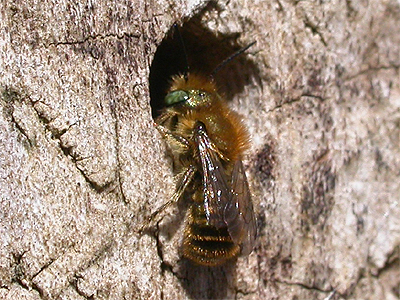 |
We're now approaching
June and are looking forward to the first migrant moths,
which should hopefully include Bordered Straw. Bordered
Straw is one of the few regular migrants we thought we
would have trapped before now. Early this year large
numbers arrived on the continent and the first have
already reached as far inland as Derbyshire. 2015 is
being predicted to be the best year since 2006 for
migrant moths. We hope so. One of our most recent finds was on the rubbish bin, in the form of a small spider with a length of little more than 2mm. The obvious red legs got us thinking and we took some photographs which later showed it was Entelecara acuminata and a new species for us. Another recent first for us and the garden, was Osmia caerulescens (the Blue Mason Bee). The females are the reason behind the common name, but the males are quite different with a noticeable shiny, metallic gold abdomen. Males are also appreciably smaller than the numerous Osmia bicornis males. In fact, we pretty certain that its been the best Spring here for Solitary Bees, with many around in good numbers. |
|
| May 10th - Wellow Park
It was a return trip to Wellow Park today, much better weather and a few weeks since our last visit, so we hoped to catch up with Megabunus diadema, which eluded us last time. The trick to finding it is Ash and at Wellow, certain sections have been coppiced over the years and diadema seems to like it. As recorders looking for it, the smooth bark of Ash helps to pick it out, although they are crafty and keen-eyed little buggers, which dart round the other side of the trunk as soon as they set their eyes on you. We found five in their favoured area. From an entomologist's viewpoint, its an under-recorded site. Not brilliant for its variety of Coleoptera, but there are always invertebrates to find. Of the beetles found today, many have only just begun appearing in Nottinghamshire for the first time this year. |
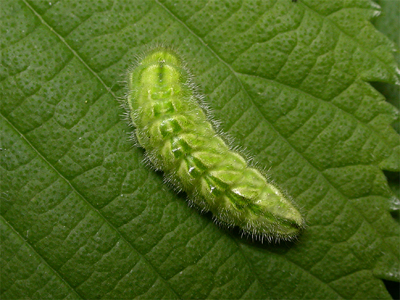 |
|
| ... | ||
| Even with an improvement
in the temperature of late, insects seem slow to catch up
and its been a funny year so far. Most Shieldbug numbers
are low this year, although Pied Shieldbug has done well
and there are few Ladybirds around. Numbers of 7-spot and
14-spot Ladybird are well down from what we have seen,
but will obviously bounce back from a cyclical lowpoint
in populations. Beating is a collecting technique we have rarely utilised for some reason, but it is often extremely profitable and reveals insects you have no idea are even there. For anyone not of an entomological nature, 'beating' is the technique of hitting the lower branches of trees and shrubs with a stick over a wooden-framed white sheet. Anything interesting can then be potted up and looked at later. Its not a random process and knowing your species, often means you are selective in what tree or shrub is beaten. Knowing what to beat and in what location to beat it helps. |
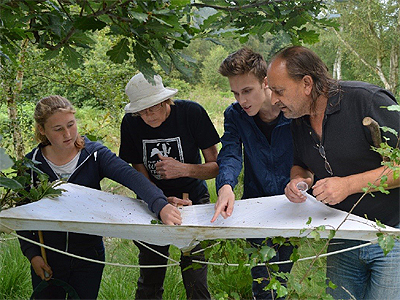 |
|
| ... | ||
| Butterflies have had another good Spring and first broods are now almost over for some early species. One butterfly yet to appear on the wing, turned up quite unexpectedly when we used the beating tray on a Wych Elm overhanging a sheltered woodland ride. Three White-letter Hairstreak larvae (top photograph of this post) fell onto the sheet and we abruptly interrupted a mating pair of Micropterix tunbergella - our first ever record of this small and very attractive moth. | ||
| ... | ||
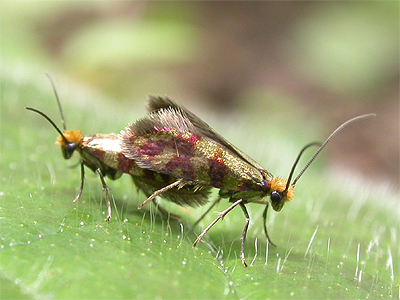 |
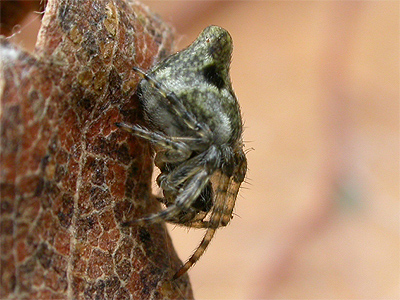 |
|
| Two larval
cases of the micromoth Psyche casta, were found
in the more shaded sections of the wood. We'd never
recorded P. casta here before, so there's
another new dot to go on the species maps next December.
Another nice record was Cyclosa conica - a
spider with an unusually shaped abdomen which gives rise
to it's latin name. Its not a species we find a great
deal and for an orb-web weaver, is small and
inconspicuous. A selective list of Coleoptera found (most by beating) follows; Dalopius marginatus, Byturus ochraceus, Cantharis pellucida, good numbers of Epuraea aestiva, lots of Meligethes atratus and even more Grammoptera ruficornis. Weevils included two Neocoenorrhinus aequatus on Hawthorn and both Liophloeus tesselatus and Barynotus moerens on Dog's Mercury. |
||
| May 9th -
Sherwood Forest CP Another visit to Sherwood this morning, largely to see if the Hazel Pot Beetle Cryptocephalus coryli was out yet. It turned out that it was'nt and neither were most other beetles which are found around the same time. |
||
| ... | ||
| There were a
handful of Lochmea caprea (another leaf beetle)
and Tetrops praustus (a small longhorn beetle)
on scrub Birch, but it was a struggle to really find
much. The Click Beetles Ampedus balteatus and Ampedus pomorum were out, but only in ones and twos though and only one Athous haemorrhoidalis shows how poor it is for early May. Oonops pulcher is a small, pink coloured Spider of woodland and is best found by sorting through leaf litter on a white sheet or tray. We find it regularly by sampling leaf litter and debris taken from within the hollow trunks of ancient Oaks at Sherwood Forest, but getting a decent photograph of it is another matter. No problem finding it today and we finally got a few photographs as well. |
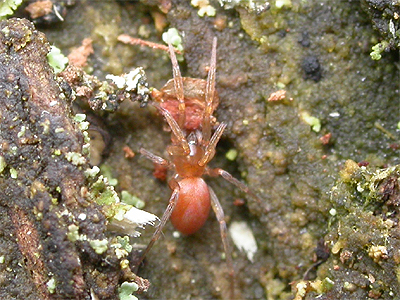 |
|
| May 4th -
Warsop Wood The late George Formby's catchphrase "its turned out nice again" (missing out the "he he" bit), is perhaps appropriate to Warsop Wood. A good stone's throw from where we live, Warsop Wood was reminiscent of a WWII battlefield last year, with much thinning work carried out and tree removal looking like it had been contracted out to Rommel's Panzer division! |
||
| ... | ||
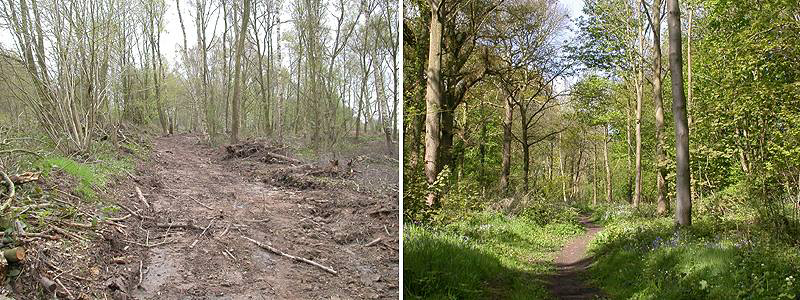 |
||
| ... | ||
| Happily, it looks much better this year and is well worth a visit. Unfortunately, the local (Church Warsop) off-road motorbikers like it and continue to gain access, despite attempts to stop them. Its only a metter of time before they cause serious accident or injury and hopefully only a matter of time before we find one of them wrapped round a tree with a headache! | ||
| ... |
| May 2nd -
Cuckney Even short periods out often produce something and with limited time today, we decided to have a look at a small copse of old Beech near Cuckney Dam. On arrival, it was nice to find that a couple of large limbs had dropped in the past couple of years and that they had either been left where they fell, or cut up and left near the footpath which runs into Cuckney village. |
||
| ... |
| Lifting some bark
provided two Corticeus unicolor (RDB3)
underneath, along with examples of Rhizophagus dispar,
nitidulus and bipustulatus. A very nice
start then? With them were some much smaller beetles, at
first glance even barely detectable as being a beetle. We
took some home for further examination and photographing,
keying them out to be the Histerid Paromalus
flavicornis and a new species for us. Wanting to photograph them actually on Beech, we took a few sections of bark with us and a couple of specimens of another beetle, that may have been Diplocoelus fagi, but which proved uncoperarative to photograph live and made sudden dashes for freedom, when some idiot (I think it was me) failed to put the lid back on correctly. However, the bark proved to be more interesting than we expected and the back end of a beetle was found in one of the many small workings. It took a while for Dilys to coax it out and was keyed out to be Beech Bark Beetle - Taphrorychus bicolor. |
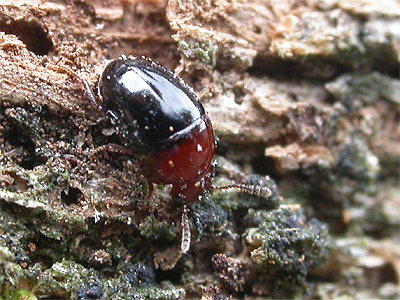 |
|
| ... | ||
| It was also good to find Salpingus planirostris in with several Salpingus ruficollis and when we made an even shorter visit the next day, to try and locate another possible Diplocoelus fagi, we found the tiny Agathidium nigripenne (above right) instead. It often pays to revisit sites. | ||
| April 26th - Crookford
Before going further, most people might not have a clue where this quiet spot is. It sounds like it might be over the border in some foreign county like Derbyshire, but its well tucked away near Bothamsall. The delightful River Poulter runs through it and access can be via Red Hill Lane from Bothamsall, or arriving via Coalpit Lane and Cross Lane from Elkesley might be better. It had been many years since we had last visited Crookford and judging by the state of the track to the site, it might be a while before we visit again. The 4x4 lot have obviously found it and had a great deal of fun trying to get wedged, waist deep in mud there by the looks of it. Pity that none had succeded really.We're all for people having fun and enjoying the countryside etc, but when their pastime ruins it for the majority, then they can bugger off. Off-road motorbikes can do the same. |
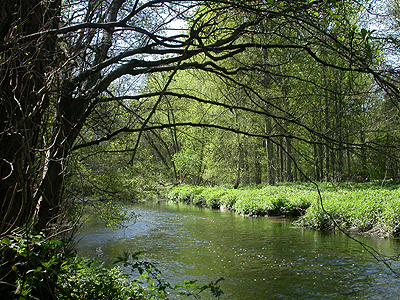 |
|
| ... | ||
| But despite the off-putting picture we've painted, Crookford is still a lovely little spot to visit. It also has potential for some interesting species to turn up, with wetland habitat and some small remnants of dry heathland where they've not planted Pines. | ||
| ... | ||
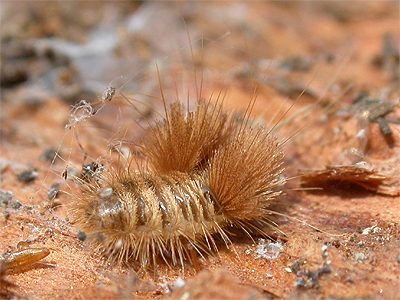 |
A surprising find under
loose Pine bark, was the larva of Ctesias serra,
which is more commonly as the Cobweb Beetle and something
of a Sherwood Forest speciality in Nottinghamshire, with
most records coming from the Sherwood Forest Country Park
and a couple from Clumber. The larva lives in crevices and under the bark of ancient trees, feeding on the left-over meals of spiders. The hairs are part of its defence mechanism against attack by spiders - thrusting them forward when threatened. The adult beetle is dark brown in colour and rarely seen. Two each of Nalassus laevioctostriatus and Phratora laticollis were also under the same bark, with the latter Beetle probably being here in large numbers, as Poplar is present. Common enough beetles, Poecilus cupreus and the colourful Elaphrus riparius were nice to see and there had been a good emergence of the common Weevil Phyllobius pyri on the scrub Birch in an open grassy heathland area, which looks absolutely perfect as potential Cryptocephalus coryli habitat. |
|
| ... | ||
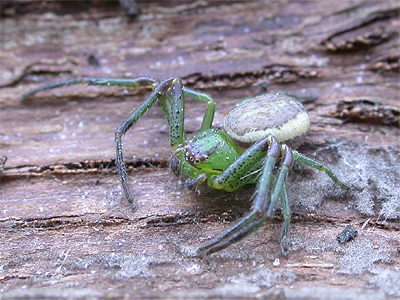 |
A dry bank with little
vegetation, provided a record of Steatoda phalerata,
which we usually find in the heathland areas of Sherwood
and a female Diaea dorsata (left) was a new
species for us, when found under loose Oak bark near the
end of an old branch. Diaea dorsata is a spider of trees and bushes, mainly confined to the south of the UK. It has been recorded many times in Nottinghamshire, with most records on the Spider Recording Scheme website, coming from the north of the county. The warm, sunny weather meant it felt extremely Spring-like and there were good numbers of both Nomada goodeniana and Nomada lathburiana searching out their host Andrena bees over the dry banks. We also had our first record of Bombus vestalis for 2015. The distinctive, green Tachinid fly Gymnocheta viridis, is turning up at most sites we visit and a worn Tachina ursina was again indicative of the heathland areas of Sherwood Forest. |
|
| April 25th -
Sherwood Forest CP It was warm and sunny today, so with a few hours to spare, we thought it might be worth checking Sherwood Forest, to see if the Hazel Pot Beetle (Cryptocephalus coryli) had emerged. As it turned out, we were obviously a week or so too early, as this Spring is quite a late one and none of the other beetles found at this time of year, are even out yet. So what to do we asked? |
||
| ... | ||
|
One prospect was to look
for Midia midas, a small RDB1 spider found
inside old Oaks. Its recently been rediscovered at
Sherwood Forest (well, part of one has) so is one of our
target species for this year. We want to show everyone
what a live one looks like, but it might take us some
time. Another suggestion was to go in search of another, almost mythical beast. Now the Oaks of Sherwood Forest are riddled with holes of a well known and notorious beetle, whose presence at sites is indicated by the conspicuous 3-4mm exit holes it makes in the dead wood of trees. Was it worth looking for the adults? Xestobium rufovillosum (The Death Watch Beetle) is a notorious pest of wood (including antique furniture) and is obviously widespread and common in the ancient Oaks of Sherwood Forest, but the actual beetle is not often encountered and we had never seen it. |
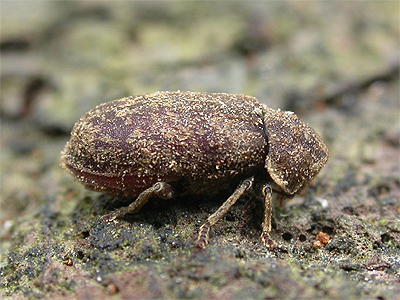 |
|
| ... | ||
| The Death
Watch Beetle derives its common name from the clicking
sound the male makes (possibly to attract a female, but
no one knows exactly for sure) but many years ago, when
heard coming from within household furniture, it was
considered to be the clock ticking down to the time of a
death. On our way back to the car, we checked a partly dead Oak along what's known locally as the Heather path. Its been opened up (like everywhere) to allow heathland plants to regenerate but once had some trees along it. The dead wood was loose (honest) and when we pulled it away, with several of the ubiquetous Nalassus laevioctostriatus, were two Xestobium rufovillosum. Both were quite inactive, despite the warming temperature and photographing them was easy for a change. Another new invertebrate found during our visit, was Nemasoma varicorne, a Millipede with few Nottinghamshire records though even fewer people are looking it. Its found underneath the loose bark of trees and has been recorded before from Sherwood Forest, but apparently not since 1970. |
||
| April 19th - Wellow Park
Unfortunately it was much cooler than our visit to Budby of yesterday and although it looked like it may be showery, it did stay dry and there was even a glimpse of sunshine before we left. Wellow Park is a cracking area of woodland, which the Forestry Commission generally keep quiet about. If it was situated 100 miles further south, then its wide woodland rides would be full of the butterflies we don't get in Nottinghamshire. Even the majestic Purple Emperor was once found here ..... so maybe one day? Wellow Park is notable in our books for being the easiest place to find another real treat for us invertebrate enthusiasts. But its small (isn't everything?) and is difficult to find, unless you know where to look. |
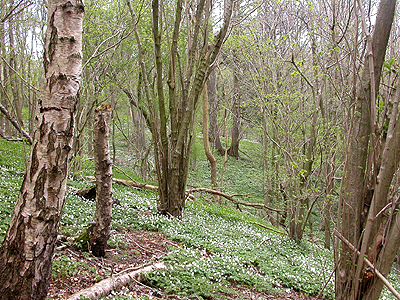 |
|
| ... | ||
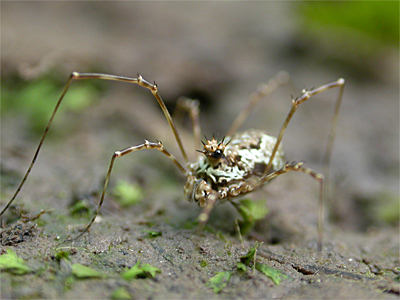 |
Megabunus diadema
(left) is the most well marked and distinctive of all our
native Harvestmen, but its cryptic colouration and small
size (3mm body length), mean that it is well concealed on
the trunks of lichen and moss covered trees it favours.
We looked in many woodlands for several years, searching
the trunks of trees before we finally found this little
gem, eventually finding it in an area of coppiced
woodland at Wellow Park. Even with the cooler weather today, we thought it would be out on its favoured trunks (young Ash trees with smooth bark, if you're interested) but there was no sign. In fact, today was one of those days when you had to go hunting for almost everything, but numerous Kidney-spot Ladybirds were more obvious (nearly always on young Ash). Other Ladybirds seem to be having a poor Spring and even finding a 7-spot Ladybird is currently something! And we have had very few Shieldbug records so far this year. Wellow is also home to one of our largest Carabids, the wonderfully named Abax parallelepipedus. |
|
| ... | ||
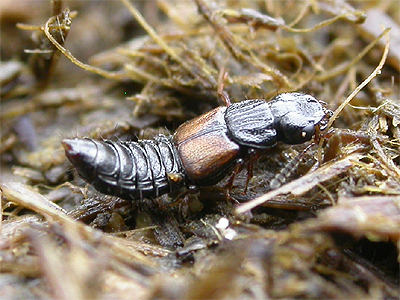 |
Turning over logs is the
best way to find it and this tactic certainly proved
successful today, with five Abax located by the
end of our visit and some elytral sections of Sinodendron
cylindricus (Rhinoceros Beetle) found under loose
bark. Dung sampling (breaking it up with your fingers) is not everyone's cup of tea. Dilys doesn't reckon much to the thought, but I'm like a kid in a sweet shop at what might be in it and just can't resist. I do use a stick for cow pats though, as even I have some limitations. One of the commonest Rove Beetles to be found in Herbivore dung during the Spring and Summer months is Oxytelus laqueatus. Its very common, but under-recorded in the county and we finally got the chance to take a few photographs of one. Back to more log turning (no pun intended) but looking under logs also provided us with the Centipede Geophilus flavus, which is not one we encounter that often and a couple of Liothobius variegatus and three Brachydesmus superus were also ample reward. |
|
| April 18th -
Budby South Forest... So how long would it take to purposefully
set out to find a new moth for the county? The answer
will be revealed shortly, or it may take longer,
depending on how long it takes to type this, or the speed
at which anyone even reads it. Deliberately setting out to find a new species for Nottinghamshire, is something we've done many times before. And if truth be told, its very often not that difficult. The key is that very few people are actively recording much of our invertebrate fauna. Butterflies are the most commonly recorded and Dragonflies too. Moths are becoming increasingly popular, as those recording Butterflies and Dragonflies develop their interest further, but pretty much anything else is still relatively under-recorded. Not everything can be solely done from the comfort of an armchair, or by using the three i's ...... an iPad, iPod or iPhone! Occasionally, it takes a lot of work and effort, sometimes even years. |
||
| ... | ||
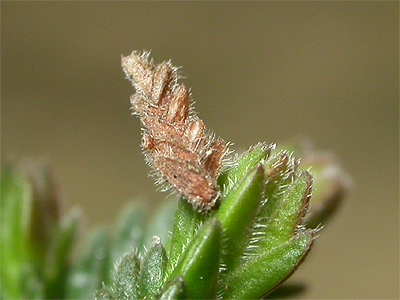 |
Last week we had an email
from our friend Martin Gray, informing us that he had
found larval cases of Coleophora juncicolella
and a first record for his resident county of
Lincolnshire. The other year he did the same with Coleophora
artemisicolella, so off we went in search for
that. The larval cases of the latter are absolute buggers to find and it took us over two weeks and many hours systematically searching the dead flower heads of Mugwort to eventually find one case. Still, it was new for Nottinghamshire, so it was well worth the time, effort and funny looks from dog walkers. We eventually located Coleophora artemisicolella on rough ground at nearby Church Warsop of all places. Church Warsop is much smaller than Shirebrook (see blog from April 2nd) but just as picturesque. The larval cases of Coleophora juncicolella are found on Heather and best located by sweep-netting. They are small, so its best to put the net contents into a container and wait. Any larvae, will then be found on the sides of the container, a few hours after return home. |
|
| ... | ||
| Budby South
Forest (more often known locally as Budby Common) is a
large area of heathland and it will come as no surprise
that its covered in large stands of Heather. Budby was
the obvious choice then, to begin to look for a 3-4mm
long larval case made of Heather in acres of heathland. Budby is dry, although there are a couple of wetter areas, sometimes even holding some water. Martin had suggested that Heather growing in damper locations might be the best areas to try, so we started sweep-netting, as soon as we walked onto the heath. Three areas of Heather were swept, till we arrived at a wet area in the middle of the heath. The swept contents were placed into a plastic bag each time for checking later, but as we were sorting out the large number of Heather Beetles and other assorted invertebrates, we spotted something else moving. Bingo! Two larval cases of Coleophora juncicolella. One was a good 3mm in length and the other half that. We were surprised at how small they were, but we had been successful in our quest and it only took 20 minutes to find a first for the county. We presume its a first and we have checked with the county recorder, but are still waiting for a reply several days later. He may be on holiday, but it still takes far too long to get simple information quickly. Maybe there is a more useful purpose for the three i's after all? |
||
| April 5th - Maun Valley ... It was the warmest day of the year so far today, so we had to go out and take advantage of the sunny weather. We thought of Sherwood Forest, but wanted to try somewhere different. We must be the only entomologists not hankering to go there and actually find ourselves starting to avoid the place more each year. | ||
| ... |
| But (like many others) we
disagree with Natural England's current management of the
site and decided on having a walk along a section of the
River Maun in Mansfield Woodhouse, located between New
Mill Lane and Old Mill Lane. Its nice to go somewhere different. It increases our coverage of the county's invertebrate fauna and usually adds a few more dots on the species maps. Its a well walked site, much used by dog walkers and as a sobering walk home for left over revellers following a night out in Mansfield. Its still a nice spot to potter around though and we will certainly be visiting again as the year progresses. The warmth brought out the butterflies and we recorded many Small Tortoiseshell, Peacock, at least two male Brimstone, a single Large White, Comma and three Green-veined White. It later turned out that these were the first Green-veined White and Large White seen in Nottinghamshire this year. |
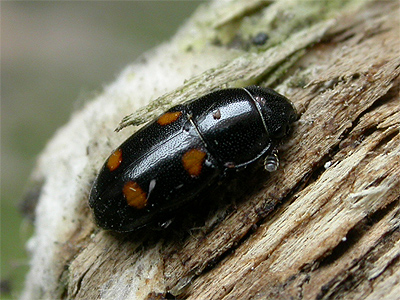 |
|
| ... | ||
| There were
good numbers of Pied Shieldbug (Tritomegas bicolor)
but no Green Shieldbug and surprisingly, not sign of a
7-spot Ladybird. A single Harlequin, was the only
Ladybird we found. Glischrochilus hortensis (above)
was a nice find, although it is a common and widespread
beetle often turning up anywhere. Other common beetles
found were Tortoise Beetle Cassida rubiginosa
and Nebria brevicollis. Numbers of the Western Yellow Centipede (Stigmatogaster subterranea) were found under a couple of turned over logs, along with the Millipede Cylindroiulus caeruleocinctus, which was quite a decent find. |
||
| April 2nd - Sookholme
Church ... Another
unlikely looking site was visited briefly today, as we
were returning home from a visit to Shirebrook.
Our advice would be to avoid going to Shirebrook. Its over the border in Derbyshire for one thing and is just about completely closed for another. Its the nearest we get to one of those deserted towns, seen in black and white Western movies of years ago. As Dilys remarked, Shirebrook does have one thing going for it .... there's a road back in to Nottinghamshire from it! Anyway, our recent ecclesiastical forays, led to us stopping off at yet another local Church at Sookholme. Its small, old and built of stone, so it may harbour our recent target species of Bristly Millipede and the Woodlouse Porcellio spinicornis. There were plenty of the latter, mostly tucked away in the stone walls nearby, but on lifting a small piece of loose mortar, we were surprised to find two Geophilus Centipedes. |
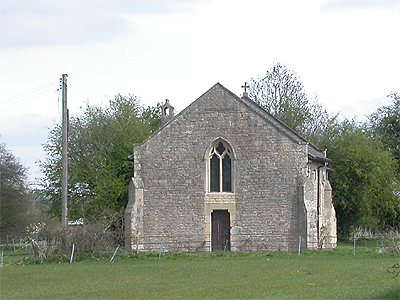 |
|
| ... | ||
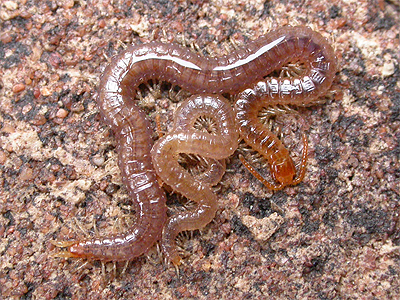 |
Our immediate thought was
that these were Geophilus carpophagus and if so,
would be the first confirmed record for Nottinghamshire. Geophilus carpophagus has frequently been confused with Geophilus easoni in the past, and only recently have the two been considered to be separate species (Arthur, et al 2001). There is a previous Nottinghamshire record from Bunny Old Wood, but the recorder is unknown and Geophilus carpophagus is not a woodland species, favouring more urban locations, where it can be found under loose mortar and brickwork on the walls of buildings etc. Later examination proved that our immediate thoughts had been correct, so we were extremely pleased to have got another 'hoped for' species under our belts. The only disappointing aspect of our short visit, was that we again failed to record Bristly Millipede. Its proving to be a more uncommon species than we expected, after recently finding them a only few miles away. |
|
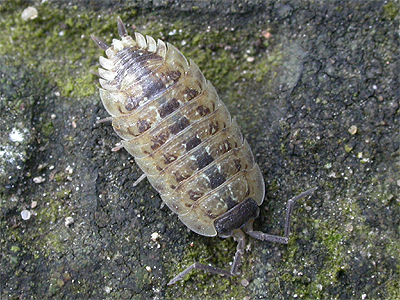 |
March 29th -
Edwinstowe/Cuckney ... The day initially dawned dry and overcast,
but the Heavens opened and it became wet .... very wet. Being Sunday, it was off to Church and this week we chose to grace the congregation at Edwinstowe with our presence. Fortunately, by the time it had stopped raining, the Sunday service was over and the Church was locked when we arrived. Just time to search for Bristly Millipedes then? Searching was difficult, as there was very little loose mortar and where some sandstone was flaking, it was usually far to dry and dusty to support much in the way of over-wintering invertebrates. Not a complete waste of time though, as a particularly well marked, large Woodlouse, was uncovered and instantly recognisable as being Porcellio spinicornis. |
|
| ... | ||
| Others were found, but all were considerably smaller than this adult. We were'nt sure of its Nottinghamshire status, but there was a record listed on the NBN Gateway, from West Bridgford in 1975. We drove a few miles to try our luck at Cuckney Church and found Porcellio spinicornis under most of the loose mortar we checked. No Bristly Millipedes at either Church, or on the surrounding stone walls, but checking walls is certainly an interesting and occasionally rewarding method of recording invertebrates. | ||
| March 27th - Church Warsop
... Spring
is taking a long time to get here this year. Its very
much reminiscent of Spring 2013, which was largely dry
and cool. Overnight temperatures have mostly been well
below 10°C and its rarely reached above that in the
daytime. All in all, we've still not been out a deal yet, but snatched a chance to have a quick wander around Warsop Church, while on a visit to the Doctors. Unfortunately the walls of our local Parish Church are well maintained and there was no loose mortar to pull out and look behind. We were after Bristly Millipede (Polyxenus lagurus), not (so we thought) seen in Nottinghamshire for over 100 years, but found to be widespread on many Churches in neighbouring Leicestershire and Rutland. It therefore seemed logical that they would be on many Nottinghamshire Churches. |
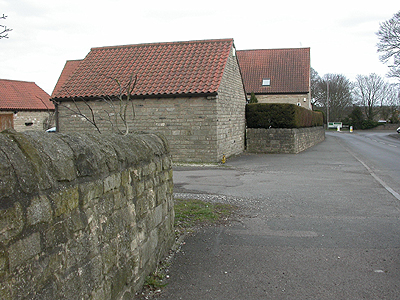 |
|
| ... | ||
| There was very little to be found on the Church itself, so we turned our attention to the stone walls just over the road. We were hopeful that we might locate the larval cases of the moth Dahlica lichenella, which used to be found on the wall of the nearby Cemetary. A few minutes of searching provided very little, apart from three interesting looking Millipedes underneath loose mortar, but then we struck lucky, finding several probable Bristly Millipedes. | ||
| ... | ||
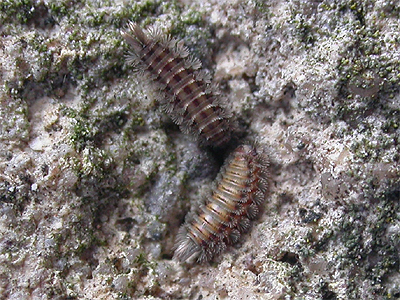 |
Unfortunately, my eyes
certainly are'nt what they were and everything within two
feet and with six or more legs, is now completely out of
focus. Even with glasses on, I still couldn't make them
out properly and neither could Dilys. So we 'borrowed'
the mortar and took it home with us. A hand lens proved that they were indeed Bristly Millipedes ... and that we both needed stronger glasses! On one small peice of mortar were five Bristly Millipedes of varying sizes, with the smallest being approximately 1mm long. They move quite quickly, so proved a little difficult to photograph, but they eventually settled down. At the time, we thought this was the first Nottinghamshire record for just over a century, but it has turned out that there are two previous records for Attenborough NR, tracked down on the NBN Gateway. We're sure that we had checked before compiling our recent publication "An Atlas of Nottinghamshire Millipedes" a few months ago. |
|
| ... | ||
| Even the British Myriapod
and Isopod Group (who very kindly sent us all their
Nottinghamshire records) had no records for Bristly
Millipede from Nottinghamshire in their database. The search now goes on for more records. We are led to believe that it has been recorded from Attenborough Church more recently, so we'll probably be coming to a Church near you at some time. The other success was the previously mentioned ' three interesting looking Millipedes', which we were later able to identify as Choneiulus palmatus. As with most Myriapods, this is a difficult Millipede to identify to species level and Choneiulus palmatus is impossible to separate from Proteroiulus fuscus and Nopoiulus kochii, without the aid of a microscope. It seems very much a Millipede of buildings and urban sites, but this was still a surprise find and a first county record. Amazing what turns up in the most unlikely of places. |
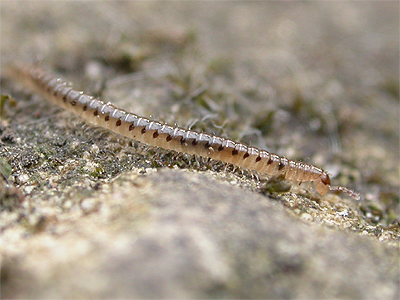 |
|
| March 7th - Sherwood
Forest/Budby ... The first real taste of Spring today, with
some warm sunshine, which was slightly tempered by the
breezy conditions. It was more than warm enough to encourage a range of invertebrates to put in their first appearance of 2015 and really kick-started the season. This may only be temporary though, as cooler temperatures are forecast, so we'll have to wait and see what happens. We decided on a walk through Clipstone Old Quarter to the far end of Sherwood Forest. Its the quietest area of the Sherwood Forest Country Park and rarely visited by the tourists. For the coleopterist, there's usually something to find, but it can be a difficult area to work, with often little reward. There's no under-storey vegetation and certainly no real nectar source in the Spring and Summer to increase species variety. But Sherwood Forest is not being managed for its potential biodiversity of species .... its more selective than that. |
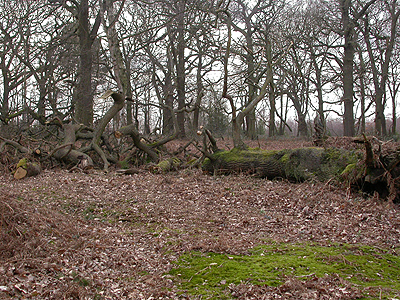 |
| ... | ||
| Sherwood
Forest is renowned for its range of dead wood
invertebrates and there's certainly plenty of dead and
decaying wood there. The rate at which the Oaks are
falling, or limbs are breaking off is quite alarming, but
should be expected when the forest (and the immediate
area) is being over thinned or felled. Sherwood's basically being opened up far too much in our opinion. The trees which have helped protect the ancient Oaks, are (or have been) removed, as part of the on-going management of the site. Consequently, its been opened up to such an extent, that strong winds will continue to wreak havoc among the Oaks at Sherwood. Its all been done far too quick and on too large a scale. Better in our opinion to trial thinning one section, leave it alone for a number of years and see if it works, before doing the whole lot. |
||
| ... |
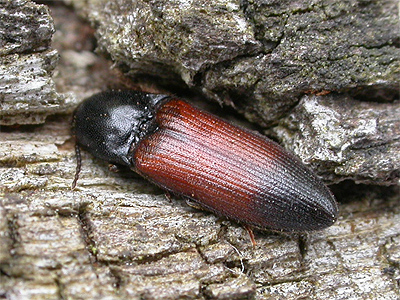 |
Budby South Forest is
Nottinghamshire's largest single area of lowland heath
and like everywhere else in the Sherwood Forest NNR, its
seen plenty of 'management'. Far too much scrub
clearance, felling and now considerably over-grazed,
Budby is a shadow of the site it was twenty years or so
ago. It was once 'the' place in the county for Nightjar. They thinned (a Natural England term for eradicating) the Birch/Pine scrub and grazed most of the sword to ground level. The Nightjar promptly deserted the place and now they're reinstating scrapes where Nightjar used to nest, in order to try and get them back. Rather remarkable, considering they were supposed to be protecting and encouraging Nightjar! Anyway, we've somehow digressed (unusual?) from the day. We found very little as we walked through Sherwood. The nationally notable Ground Beetle Pterostichus oblongopunctatus, was easy to find under partially sunk logs and the attractive Click Beetle Ampedus balteatus (left), turned up at the base of one of the Oak remnants. |
|
| ... | ||
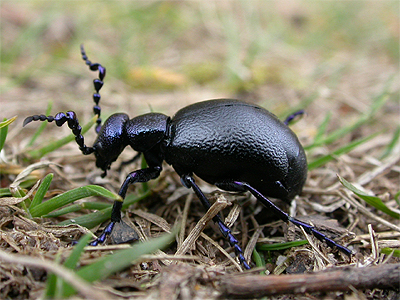 |
With the weather warming
up more, we decided to walk further on to Budby and check
for the first emerging Oil Beetles. We were pleasantly
surprised to find two immediately on arrival, then
delighted to find a total of 36 after a thorough survey.
All but one were males. Budby also provided us with our first Bumblebee of 2015, seeing (presumably the same) Bombus hypnorum several times within a few minutes. With the day being pleasantly warm, we decided to revisit Clipstone Old Quarter later in the afternoon/evening, for our first Glow Worm larva survey of the Spring. Arriving at dusk, we were very pleased to find one 15mm larva on the edge of the path. It seems that Spring has finally sprung. We then ended the day by having a short moth trapping session, despite the breezy conditions. A decent number of moths were recorded, but low numbers of some species. Its been a slow start to the year for moths. |
|
| March 1st - Gunthorpe ... Decided to make the trip down to
the Trent Valley this morning for a couple of hours. Its
not an area we visit very often, although we intend to
cover it more this year. Hoveringham was the intended venue, but at the last minute, we decided on visiting Gunthorpe instead. Whether it was the right place to go will never be known, but we chose it as we thought there would be better habitat than at Hoveringham. With the weather being dull and drizzly on the way there, it brightened up on our arrival, though even some sunshine could not make Gunthorpe Bridge look anything better than the most dull-looking bridge in the UK. I'm sure it was white years ago. However, although the weather was bright, the welcome from the local angling clubs was not quite so bright. Keep out and private property signs were all over the place, so of course we completely ignored them and ventured forth to see what we could turn up. |
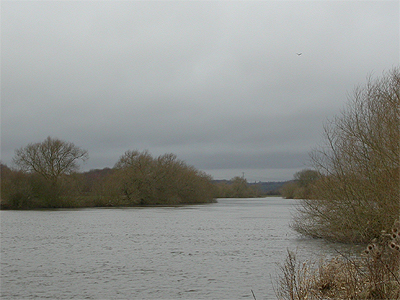 |
|
| ... | ||
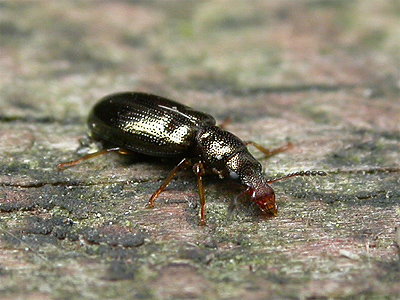 |
The Trent Valley is very
different from Sherwood Forest. Not so much dead wood
habitat, but there were plenty of old Ash tree in various
states of rot and decay. Plenty of fallen branches too,
which provided us with records of Biphyllus lunatus
and Salpingus planirostris from under Ash and
Willow bark respectively, but nothing else of any real
note. It will be much more rewarding in Spring and Summer no doubt, so until then, here's a list of beetles recorded from the visit. Ocys harpaloides, Dromius quadrimaculatus, Bembidion tetracolum, Oxypselaphus obscurus and Pterostichus diligens (Carabidae), Crepidodera aurata (Chrysomelidae), Lathrobium brunnipes, Rugilus rufipes and Othius punctulatus (Staphylinidae). Centipedes and Millipedes included Brachyiulus pusillus, Cryptops hortensis, Cylindroiulus punctatus, Geophilus truncorum, Lithobius forficatus, Polydesmus angustus, Polydesmus inconstans and Tachypodoiulus niger. |
|
| February 25th
- Eakring Flash ... It's been a long time since there's been a
deal to write about and to be honest, we've not been out
that much. But we paid a short visit to Eakring Flash
today, just for the purposes of pulling a few Bulrush
stems apart. Done sparingly (depending on the amount of Bulrush) its a great way of recordig invertebrates during the Winter months, with the added advantage of knowing that anything you find, is not likely to be in much of a hurry to get away and there's a better chance of getting a few photographs. There's always plenty to find in Bulrush stems. Hollow stems created by the larva of Bulrush Wainscot, will usually reveal good numbers of two common spiders - Hypomma bituberculatum and Clubiona phragmitis. |
||
| ... |
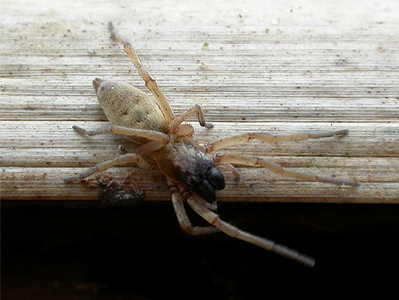 |
Several Clubiona
phragmitis (left) of differing sizes, will crawl out
of most hollow stems, but split the stem upwards or
downwards with a fingernail and there are often several
over-wintering beetles and other invertebrates tucked
away. This is one of the best ways to find the diminutive Water Ladybird (Anisosticta novemdecimpunctata) which by late February, is already assuming the pink colouration shown by Spring adults. The rest of the year, they attain a dull straw colouration and are certainly far less attractively coloured and more difficult to find visually. We found three Water Ladybirds today and a less well-known Ladybird in the form of Coccidula rufa. This colourful beetle is probably common across much of Nottinghamshire, but its small size renders it less conspicuous and sweeping is supposed to be the best method of finding it. |
|
| ... | ||
| Our main aim of the
visit, was to try and find the tiny Hygronoma
dimidiata (right). We'd found this distinctive Aleocharine Rove Beetle at Eakring Flash the year before, but it proved impossible to photograph and so never appeared on the website. It took some finding, but proved much easier to find on the dead flower stems which still retained the dead heads from last year. Pulling the leaves away from the stem, soon revealed around half a dozen and at least one of which liked being photographed. It was a fairly mild day, so as soon as anything was in the sunshine, it soon made a run for it. The extremely tiny Psammoecus bipunctatus (below right) also turned up with large numbers of Cyphon laevipennis. |
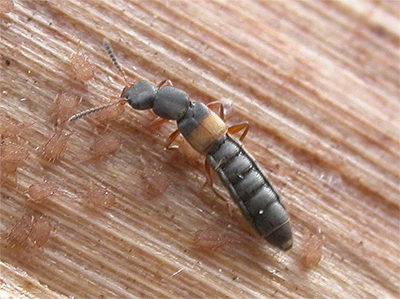 |
|
| ... | ||
| Somewhat resembling a
Ground Beetle in shape and measuring around 3mm in
length, Psammoecus bipunctatus is easily
small enough to be missed and is soon heading for cover
when disturbed. If it occurs at a small and relatively new (formed in 1997) site such as Eakring Flash, then it should really be widespread at many Trent Valley locations with long-established reed-beds. The males are smaller than females and less well marked and they are easy enough to identify in the field with a hand lens. For those still reading this (probably not many by now) and those still interested in what else we found (probably even fewer) here's a brief list of what else we found. Agonum fuliginosum, Agonum thoreyi, Trechus quadristriatus and Pterostichus niger (Carabidae), Alianta incana, Anotylus rugosus, Stenus brunnipes and Tachyporus solutus (Staphylinidae) and the Weevil Sciaphilus asperatus (Curculionidae) which was also a first record for us. |
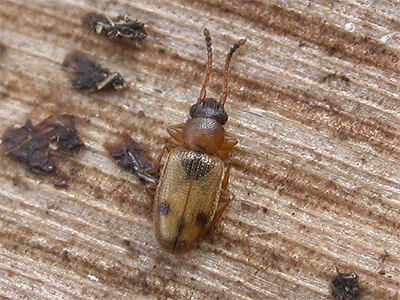 |
|
| January 11th - King's Clipstone ... With a less windy and much better day dawning, there was time for an hour or so out and about. In the end, out and about turned out to be be well worth the effort and going somewhere we had only been to once, but not exactly to this particular spot. | ||
| ... | ||
| King's Clipstone is more well known
for the historic remnants of King John's Palace, than its
invertebrate diversity, which basically comes through no
one ever having gone there to see what invertebrates they
could find. After all, its not Sherwood Forest is it? so
what's there to find? After walking through the former flood meadows in the direction of Clipstone (King's Cipstone is the old bit and Clipstone is the mining village, with not much to go for it) we diverted off the public footpath, as soon as a hole became available in the fence for us to get through. We were also out of the way of an endless stream of mountain bikers and on to the former colliery railway line. Much better habitat here and with long deposited piles of building rubbish. Among the rubbish was lots of old roofing felt, which always hosts numerous inverts and is usually good for beetles, even on mild Winter days. Not really that much in beetle terms, just a pair of Nebria salina (not a species we see much of) singles of Silpha atrata and Cychrus caraboides and a few others patiently awaiting Spring. However, this time of year is a good time to get to grips with Myriapods - which are Centipedes and Millipedes to most reading this and an old piece of carpet proved interesting. It held the obligitory Cylindroiulus punctatus, a nice Blaniulus guttulatus (below right) and an a small Millipede which became very active immediately on seeing the sunlight, or it may have been us? Just its very habit made us suspect something different, so we took many photographs on site and took it home to try and get some more. If you take 100 photographs of most active Millipedes with no flash, you'll be lucky to get two you can call OK for your efforts. Thankfully, photographs took at the time, plus many more on return home, were enough to help us realise this was an interesting find. After examination under the microscope, it turned out to be Chordeuma proximum (above right) and a first record for Nottinghamshire. Chordeuma proximum is known to have a strong south-westerly distribution in the UK, with the nearest known site to Nottinghamshire, being in Worcestershire. Millipedes and Centipedes have been poorly recorded in recent years, so further searching may well reveal this 14mm long species to be quite common. All in all, not a bad few hours out and about. |
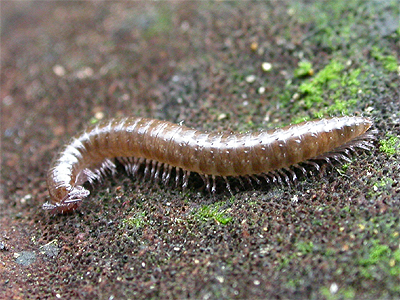
|
|
| January 10th ... Not been able to get out and about
much this past week, so decided to sit down and catch up
with some long overdue moaning, which we've found becomes
more frequent as you get older and the more you look at
habitat management from an invertebrate aspect. From an invertebrate aspect, the demise of the Nottinghamshire coal industry has certainly been no bad thing and some excellent habitat has been created as a result. Unfortunately though, no one has had the foresight to leave any former pit top well alone and let nature take it's course and so glaring opportunities to create some diverse new habitats on the many former pit tops of the county, have largely been missed. Instead, all we have got from the landscapers, have been dozens of former pit tops all looking pretty much the same. Grass them over and over plant with as many whips (young trees) as they can. With a bit more thinking, couldn't they have grassed them over (or just left them) and let areas of scrub develop? Far more potential. |
||
| ... | ||
| Now scrub is a bit of a
dirty word in conservation, its a bit like saying Birch
to someone from Natural England, and the mere mention of
either word will usually see you get disapproving looks.
Scrub is useful for many birds and invertebrates, but too
much of it is removed in our opinion. The removal of
scrub is usually excessive at many sites, but is usually
part of a management plan written by someone fresh out of
University, which apparently makes it right. Scrub is also the precursor to woodland, and naturalised woodland is a rare thing. It would just be nice to have a bit of woodland which is not managed and left to develop. What an interesting study that would make, just as good a study as monitoring the species diversity and its changes on any former pit tops. Unfortunately that opportunity has long gone, but it would have been nice for someone to have had the opportunity to see what species colonised a site first, to see how the populations of those species changed as the habitat developed, how new species moved in and others left. Its all part of a natural progression. |
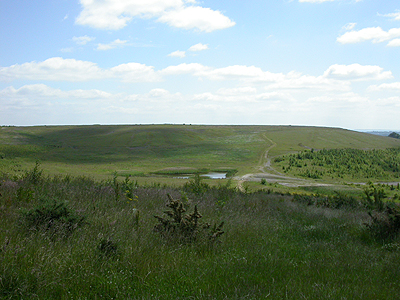 |
|
| ... | ||
| Gedling pit
top (now a 'country park' so it must be good) was the
last of our former pit tops which had remained relatively
untouched. As a consequence, it was liked by many who
visited it for its attractiveness to rare birds and for a
few of us who went there for its invertebrates. Now the
landscapers have been in, tidied it up for the public and
called it a country park, its value as a site for many
species, has effectively been lost. If only they had visited the former Shirebrook pit top, now called Shirebrook pit wood. Although it does have acres of the standard young trees (why plant water-loving trees like Alder on the driest part of a pit top?) some wonderful wetland habitat has been created. Bevercotes Pit Top is another which does have some great habitat and large areas of flower rich grassland. Both are well worth a visit, to see what can be done, but we've still missed a fabulous opportunity to create some much needed grass/scrub habitat. |
||
| January 4th -
Warsop Main Pit Top ... After a hard overnight frost, we decided to
have an hour counting over-wintering Ladybirds on Warsop
Main Pit Top (its much nicer there than it sounds). We'd
had four-figure counts several Winters ago, so were
hopeful of a decent count today. It wasn't as easy as we had thought it would be and after checking all the small Pines on the lower section of this part of the site, it wasn't until we reached the very top that we found our first 7-spot Ladybirds. Despite the recent snow and several very forsty mornings, 12 hardy souls were eventually found tucked well in the needles at the very top of the young Pines. With nothing else obvious in the open, a quick check under the loose bark of some of the more mature Pines, turned up three Cream-streaked Ladybirds - not a species we have found there very often. |
||
| ... | ||
| January 1st -
Sherwood Forest ... With the snow present since Boxing Day now
almost gone, 2015 dawned overcast and very mild, with a
temperature just reaching into double figures. The
spider, Zygiella x-notata provided our first
invertebrate record of the year, in the final process of
completing a new web on one of the kitchen windows. A not
unexpected start to the year. The plan later, was to go to an area of the Sherwood Forest CP to look for Boreus hyemalis (below right) more frequently known as the Snow Flea. Unusual among insects, Boreus hyemalis is active throughout the Winter months and its habit of being found on lying snow and making short jumps to escape, have led to the common name of Snow Flea. It's the less well known of the UK's four species of Mecoptera (Scorpion Flies) and very small. |
||
| ... | ||
| On January 2nd 2014, we
found the first record for Nottinghamshire, but despite
mild conditions and still some areas of lying snow to
help see them more easily, we failed to find it. Among a number of small invertebrates found, were a moribund Dicranopalpus ramosus, a Harvestman originally of Mediterranean origin, which was probably wishing its ancestors had never found and colonised the UK in 1946. Our second ever record of the beetle Phloiophilus edwardsii (Nb) walking through the snow, was still a surprise for a species active late/early in the year. This was a beetle which we had looked for over several previous Winters, eventually finding six adults under bark, on a large section of fungus-covered fallen Oak on Budby South Forest in November 2014. On the downside of our visit, was the sight of yet more trees being felled. Its part of the on-going management of the site to open it up and once again, its Birch that is taking the brunt of the work. |
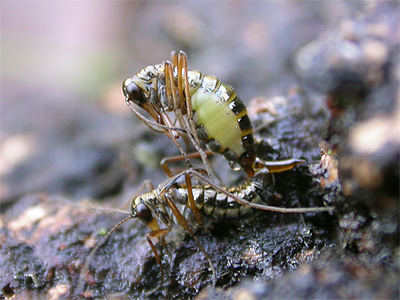 |
|
| ... | ||
| With more
healthy young trees going, it leaves another part of
Sherwood Forest with mostly old Birches - Birches nearing
the end of their life naturally. This round of felling is also in the centre of Cryptocephalus coryli (RDB1) habitat, and as usual, there seems no consideration to help maintain a supply of differently aged Birch at Sherwood Forest, even despite a Natural England commissioned report (which we co-authored) on the beetle, its habitat requirements and need for a succession of differently aged Birch. |
||